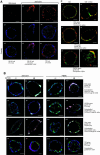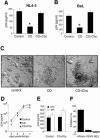Membrane raft microdomains mediate lateral assemblies required for HIV-1 infection
- PMID: 11265761
- PMCID: PMC1084257
- DOI: 10.1093/embo-reports/kvd025
Membrane raft microdomains mediate lateral assemblies required for HIV-1 infection
Abstract
HIV-1 infection triggers lateral membrane diffusion following interaction of the viral envelope with cell surface receptors. We show that these membrane changes are necessary for infection, as initial gp120-CD4 engagement leads to redistribution and clustering of membrane microdomains, enabling subsequent interaction of this complex with HIV-1 co-receptors. Disruption of cell membrane rafts by cholesterol depletion before viral exposure inhibits entry by both X4 and R5 strains of HIV-1, although viral replication in infected cells is unaffected by this treatment. This inhibitory effect is fully reversed by cholesterol replenishment of the cell membrane. These results indicate a general mechanism for HIV-1 envelope glycoprotein-mediated fusion by reorganization of membrane microdomains in the target cell, and offer new strategies for preventing HIV-1 infection.
Figures




References
-
- Berger E., Doms, R., Fenyo, E., Korber, B., Littman, D., Moore, J., Sattentau, Q., Schuitemaker, H. and Sodroski, J. (1998) A new classification for HIV-1. Nature, 391, 240. - PubMed
-
- Brown D. and London, E. (1998) Functions of lipid rafts in biological membranes. Annu. Rev. Cell Dev. Biol., 14, 111–136. - PubMed
-
- Callebaut C., Krust, B., Jacotot, E. and Hovanessian, A. (1993) T cell activation antigen, CD26, as a cofactor for entry of HIV-1 in CD4+ cells. Science, 275, 2045–2050. - PubMed
-
- Dimitrov D. (1997) How do viruses enter cells? The HIV coreceptors teach us a lesson of complexity. Cell, 91, 721–730. - PubMed
Publication types
MeSH terms
Substances
LinkOut - more resources
Full Text Sources
Other Literature Sources
Medical
Research Materials

